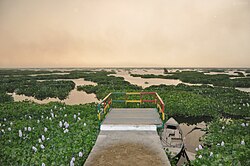



A Ramsar site is a wetland site designated to be of international importance under the Ramsar Convention, [1] also known as "The Convention on Wetlands", an international environmental treaty signed on 2 February 1971 in Ramsar, Iran, under the auspices of UNESCO. It came into force on 21 December 1975, when it was ratified by a sufficient number of nations. It provides for national action and international cooperation regarding the conservation of wetlands, and wise sustainable use of their resources. [1] Ramsar treaty participants meet regularly to identify and agree to protect "Wetlands of International Importance", especially those providing waterfowl habitat.
Contents
- List of Sites
- Criteria for Ramsar sites
- Classification System
- Marine/coastal wetlands
- Inland wetlands
- Human-made wetlands
- See also
- References
- External links
As of December 2025 [update] , there are 2,550 Ramsar sites around the world, which protect 258,029,214 hectares (637,604,070 acres), and 172 national governments participate in the convention. [1]

